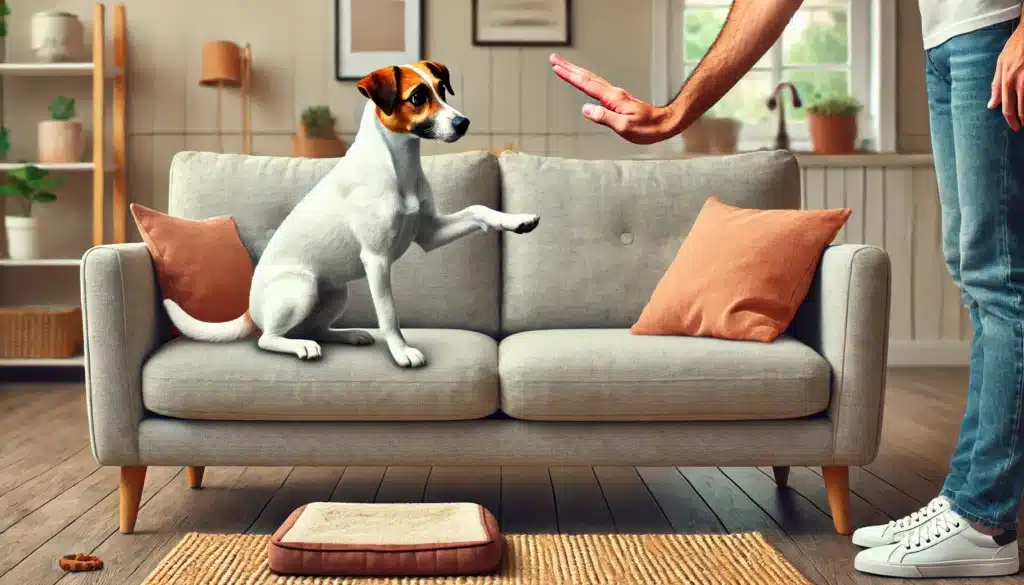For some dog owners, a pup curled up on the couch is the picture of homey bliss. For others, it’s a hard no. Whether it’s about protecting furniture, maintaining hygiene, or setting boundaries, teaching your dog to stay off the couch is possible — and easier when done with consistency, structure, and positive reinforcement.
In this guide, you’ll learn why dogs love the couch, how to train them not to jump up, and what to do if they keep testing the rules.
Why Do Dogs Love the Couch?
To your dog, the couch is more than a comfy spot — it’s warm, elevated, and smells like you.
Reasons dogs are drawn to the couch:
- Comfort: Soft cushions support their body
- Height: Dogs enjoy being up high to observe their surroundings
- Closeness: The couch usually smells like you — and dogs are pack animals
- Warmth: It retains heat better than the floor
- Habit: If they were ever allowed up once, they’ll assume it’s always okay
If you’re okay with couch cuddles — that’s totally fine! But if you’d rather enforce boundaries, read on.
Step 1: Decide on Clear Rules
Before training your dog, make sure everyone in the household agrees:
- Are dogs allowed on the couch sometimes or never?
- Are they allowed only when invited?
- Is there a designated dog couch or furniture?
Inconsistent rules confuse dogs. The clearer you are, the faster your dog will learn.
Step 2: Provide an Appealing Alternative
It’s not enough to say “no” — you have to give your dog a better option.
Create a comfy alternative spot:
- A plush dog bed or mat near the couch
- A raised cot with a view of the room
- A blanket or designated “dog chair” (if partial access is allowed)
- Include favorite toys or a chew bone for incentive
Make the new spot just as cozy and rewarding as the couch.
Step 3: Use Positive Reinforcement
Train your dog to go to their spot instead of the couch.
How to teach “Place”:
- Lead them to their bed or mat
- Say “Place” or “Go to bed”
- When they lie down, praise and reward
- Practice short sessions throughout the day
- Gradually increase distractions and duration
Eventually, they’ll learn that calm behavior in their spot = rewards.
Step 4: Remove Reinforcement from the Couch
If your dog continues jumping on the couch, it’s because they’re still getting something they like from the experience.
Remove the reward:
- Don’t pet or talk to them while they’re on the couch
- Gently guide them off with no attention or emotion
- Reward them only when they choose their spot or stay on the floor
Avoid yelling or harsh corrections — these can increase anxiety or confusion.
Step 5: Use Physical Barriers When You’re Away
Dogs are opportunists. If they’re alone and the couch is accessible, they may go right back to it.
Tools that help:
- Baby gates to block off the room
- Furniture covers with textures dogs dislike (aluminum foil, plastic runners, or upside-down carpet mats)
- Couch shields or scat mats (only if used gently and safely)
- Close doors or rearrange cushions temporarily
You’re not being mean — you’re just making the couch less rewarding in your absence.
Step 6: Stay Consistent Over Time
Dogs thrive on routine and clarity. Be consistent in:
- Correcting couch jumping gently every time
- Rewarding the alternative behavior
- Keeping boundaries the same during guests, meal time, or downtime
Inconsistency resets training progress.
Step 7: Understand Special Cases
🐾 Puppies
Puppies learn fast — but need extra supervision. Start boundaries early and redirect with enthusiasm.
🐾 Senior Dogs
If your senior dog has always been allowed up, it may be harder to change the habit. Consider covering the couch with a washable blanket and accepting it — or offering a memory foam bed close by to ease the transition.
🐾 Small Breeds
Some small dogs love burrowing on soft cushions. Provide a donut bed or blanket cave nearby to replicate that comfort.
What About Allowing Couch Access Sometimes?
If you want to let your dog on the couch only by invitation, train them to wait for a specific cue:
- Teach “Up!” as a command for permission
- Follow with “Off!” when it’s time to get down
- Reward both behaviors
- Be consistent and only use the cue when you’re okay with it
No invitation = no access.
Final Thoughts: Boundaries Build Better Behavior
You’re not being unfair by keeping your dog off the couch — you’re creating structure that helps them feel secure, respected, and part of the family. With patience, clarity, and a comfy alternative, most dogs adjust quickly and happily.
The goal isn’t punishment — it’s redirection, guidance, and mutual understanding.
And no matter where your dog ends up sleeping, they’ll still love being near you. After all, your presence is the real comfort they seek.







